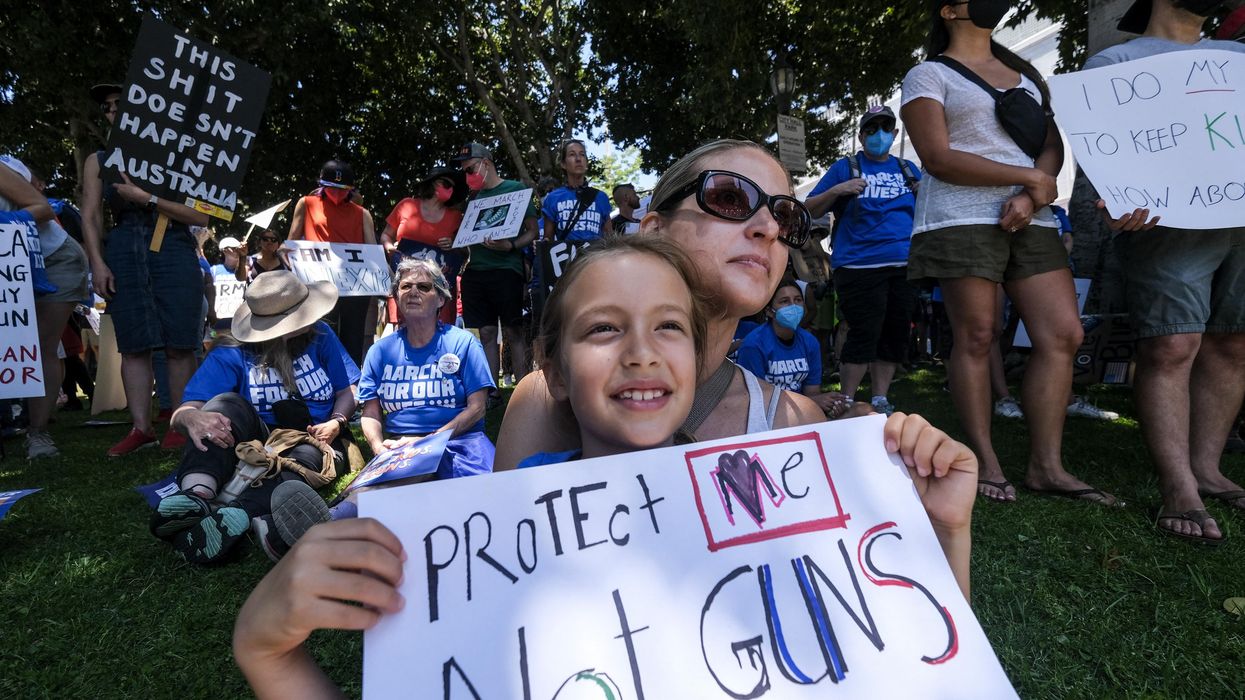Goldstone’s most recent book is "On Account of Race: The Supreme Court, White Supremacy, and the Ravaging of African American Voting Rights."
Uvalde. Another school massacre. Another underage murderer. Another legally purchased weapon of war turned on innocent children. More calls for action. More thoughts and prayers. More braying about upholding the Second Amendment. More pandering.
More nothing done.
Or next to nothing, in any event. It appears Uvalde may result in some cosmetic changes, but the chances of meaningful reform remain zero. It’s the Constitution, you see.
Despite their self-righteous defense of individual liberty, opponents of gun control do not have a lot of law on their side. To buttress their position, they generally point to Antonin Scalia’s opinion in D.C. v. Heller as controlling the meaning of the Second Amendment. In that case, Scalia and four conservative colleagues overturned two centuries of precedent to take the position that the opening of the amendment, “A well regulated Militia, being necessary to the security of a free State,” is essentially meaningless fluff, and that “the right of the people to keep and bear Arms, shall not be infringed,” were the only words in the amendment that actually matter.
Even then, the right was not absolute. Although, “The Second Amendment protects an individual right to possess a firearm unconnected with service in a militia, and to use that arm for traditionally lawful purposes, such as self-defense within the home,” Scalia and his brethren acknowledged, “Like most rights, the Second Amendment right is not unlimited. It is not a right to keep and carry any weapon whatsoever in any manner whatsoever and for whatever purpose.” He specifically noted “prohibitions on the possession of firearms by felons and the mentally ill,” and “in sensitive places such as schools and government buildings.” Needless to say, that section of the opinion is rarely cited by senators and congressmen who think a mentally ill teenager has a constitutional right to buy an AR-15.
Before Scalia’s end-run, on the altar of “enshrinement of constitutional rights,” the most important gun control opinion, and the most logical interpretation of the amendment, was that of another conservative, James McReynolds in 1939 in United States v. Miller.
Miller stemmed from a challenge to the 1934 National Firearms Act, itself a response to the carnage spawned by Prohibition-era gang wars, including the notorious 1929 St. Valentine’s Day Massacre, in which seven members of Chicago’s Bugs Moran gang were executed with machine guns in a Lincoln Park garage by Al Capone’s executioners. The law imposed taxes on the sale or transfer of a variety of hand and long guns, required certain categories of firearms be registered, and restricted the movement of firearms across state lines.
In April 1938, Jack Miller and Frank Layton, two bank robbers on the run from both the law and their associates, were arrested and charged with transporting unregistered sawed-off shotguns across state lines. Miller had every reason to feel the need to carry a weapon — in 1935, he had turned state’s evidence to avoid a prison sentence, about which his colleagues were none too pleased.
Miller, although an unlikely plaintiff, sued in federal court to void his arrest on Second Amendment grounds. The judge, a gun control advocate, sided with Miller, which resulted in Miller’s release from prison, where any number of unhappy former associates were waiting for him. The decision was contrived — the judge assumed that Miller would flee and thus allow the government to win its appeal of Miller’s dismissal virtually by default. His assumption proved correct. As soon as he was a free man, Miller promptly vanished.
As a result, when the government appealed the dismissal to the Supreme Court in January 1939, there was no one on the other side to contest its brief. Miller and Layton’s court-appointed lawyer, working pro bono, refused to do any more work on their behalf. Oral arguments — or, rather, argument — were heard on March 30, 1939, and the decision was published only six weeks later.
Speaking for a unanimous court, McReynolds told onlookers, “We construe the [Second] amendment as having relation to military service and we are unable to say that a sawed-off shotgun has any relation to the militia.”
McReynolds was perhaps more unlikely a gun control advocate than Scalia would have been. A ferocious opponent of the New Deal and federal regulation, he was described by his own biographer as “an easy man to dislike.” Deeply conservative, he was “intolerant, cantankerous, and rude,” referred to Black people as “darkies,” and refused to associate with Justice Louis Brandeis for the crime of being Jewish.
In Miller, however, McReynolds and the other justices deemed the meaning of the Second Amendment so obvious, so related to the need for citizen soldiers in a nation with no standing army, that the argument that Miller or anyone else had the right to carry whatever weapon they wanted wherever they wanted was laughable. His nine-page opinion could not have been more dismissive.
(Jack Miller, however, was not around to learn of the verdict. Four days after oral arguments, his body was found with four bullet holes near Ketchum, Okla. The crime remains unsolved. Layton, who had kept a much lower profile, was eventually given five years’ probation for violating the National Firearms Act and died of natural causes in 1967.)
The Miller decision attracted little attention at the time, since almost no one interpreted the Second Amendment as anything other than an anachronism, rendered obsolete by the creation of a professional military. And so it remained, despite numerous attempts by gun worshipers to pretend the opening clause did not exist. That they finally found their spiritual bedfellow in the person of a man fond of trumpeting his reverence for the text of the Constitution, who sneered at judges who took into account such silly factors as “intent,” is the saddest of ironies.
Americans across the nation will be voting in November and the choices they make will determine the course the United States will follow for two years, likely longer. Litmus tests tend to be counterproductive in politics, but in this case may well be appropriate. Anyone who votes for a candidate who proclaims the supremacy of a non-existent right for expediency or even political survival loses the privilege to lament, express shock, or offer thoughts and prayers the next time children are gunned down.




















